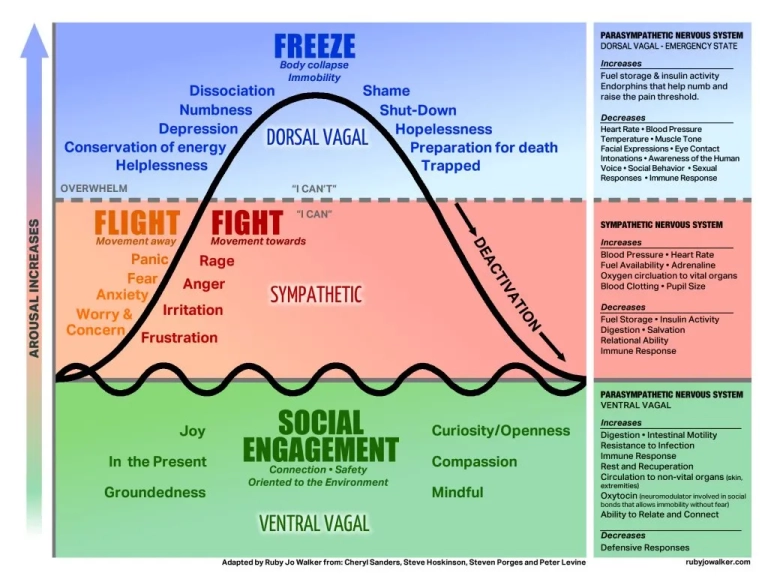What is TRE®?
Understanding TRE: Tension and Trauma Release Exercises for Stress Relief
In our fast-paced and demanding world, stress and trauma have begun to affect all aspects of our lives from the pandemic to the loss of a loved one and even work stress the list is endless. It is therefore essential to find effective techniques for managing stress and trauma. One such technique that has been gaining popularity is TRE, it is short for Tension and Trauma Release Exercises. TRE is a simple yet powerful method that helps individuals release tension, alleviate stress, and promote overall well-being. In this article, we will delve into the core principles of TRE, its connection to the polyvagal theory, and its clinical findings.
Tension and Trauma Release Exercises have been developed by Dr. David Berceli, this is a body-based technique that allows the body to release deep muscular tension accumulated through stressful experiences or trauma. The primary objective of TRE is to activate the body’s natural ability to shake or tremor, facilitating the release of physical and emotional stress held within the body. Modern research has now begun to view the fascial system as a whole enteric nervous system in itself, this was often disregarded before. However, with growing research, we have begun to understand that our fascia stores old experiences even from childbirth.
Polyvagal Theory: The Neurobiological Connection
To understand the effectiveness of TRE, it’s crucial to explore the polyvagal theory. Proposed by Dr. Stephen Porges, the polyvagal theory focuses on the autonomic nervous system’s role in regulating our physiological and emotional responses to stress and trauma. According to this theory, our nervous system operates on a hierarchical structure with three distinct branches: the ventral vagal, sympathetic, and dorsal vagal systems.

The ventral vagal system, also known as the social engagement system, is responsible for promoting feelings of safety and connection. The sympathetic system activates the body’s “fight-or-flight” response when faced with perceived danger. Finally, the dorsal vagal system induces a state of immobilization or “freeze” in response to extreme threats or helplessness.
When traumatic events occur, the body may become stuck in a state of sympathetic activation or dorsal vagal immobilization. These dysregulated states hinder the body’s ability to return to a balanced and relaxed state, perpetuating chronic stress and impacting overall well-being, and leading to autoimmune conditions and chronic diseases. Here is where TRE comes into play.
Clinical Findings: Empowering the Body’s Innate Healing
Clinical studies have shown promising results regarding the efficacy of TRE in promoting stress reduction and trauma recovery. TRE has been found to facilitate the restoration of the ventral vagal system’s functioning, allowing individuals to experience a sense of safety and connection. By engaging the body’s natural tremoring mechanism, TRE assists in discharging the accumulated stress and trauma stored in the body, thus restoring balance and harmony. It is a safe and effective tool that assists in executing the fight, flight, and freeze response. Moreover, TRE has been found to benefit various populations, including individuals with post-traumatic stress disorder (PTSD), anxiety, depression, and chronic pain. Regular TRE practice has shown improvements in sleep quality, reduction in muscle tension and pain, increased emotional regulation, enhancement in interpersonal relationships as well as resolution with work stress, and enhanced overall resilience
Incorporating TRE into Your Life
If you’re interested in exploring TRE, it’s essential to seek guidance from a certified TRE provider. These professionals will guide you through the process, ensuring your safety and providing support as you navigate your healing journey. TRE exercises can be performed at home once you have learned the technique, allowing you to incorporate them into your daily routine.
TRE offers a valuable approach to releasing tension and trauma stored within the body, promoting stress relief and overall well-being. Through its connection to the polyvagal theory, TRE empowers the body’s innate capacity to heal and restore balance. Clinical findings highlight its effectiveness in reducing symptoms of stress, trauma, and various mental health conditions. Consider exploring TRE with the guidance of a certified provider to experience the transformative benefits it offers. Remember, self-care and seeking professional support are essential steps on the path to healing and well-being.
